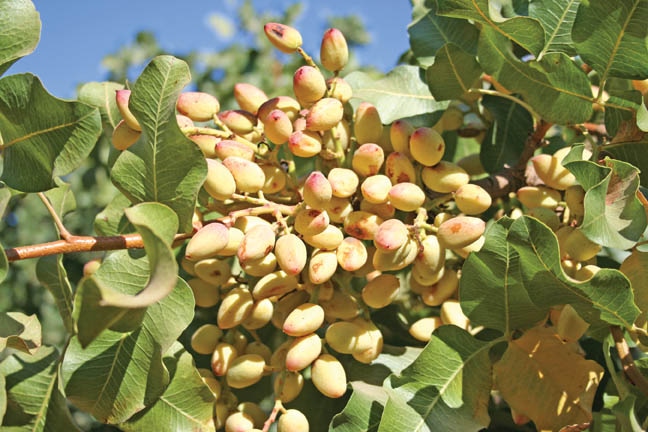
Pistachio update in Kern County
2010 season expected to be a low-yielding year.The cool spring slowed nut growth and pushed harvest back. Few trees will be harvested before Sept. 22.Treatment for navel orangeworm is ongoing.A late harvest means increased chance of crop damage due to fall rains — less of a concern in dry Kern County than in locations further north in the SJV.
September 16, 2010

Pistachio continues to be an important crop in Kern County with approximately 50,000 acres of bearing trees and thousands more of non-bearing.
Pistachio is an alternate bearing crop, and on the West Side of the San Joaquin Valley (SJV) where most of the pistachio trees are planted, the 2010 season was expected to be a low-yielding year.
However, mature trees have larger yields than I expected, although the percentage of the nuts on the tree that are blank (nuts with no kernels) appears to be in the 15-20 percent range on many trees.
The large number of new plantings in 2005 and 2004, which will be producing the first commercial yields, will also boost production this year, as will yields of some mature trees on the east side of the Valley which appear to be in the high-yielding on-year.
The cool spring and bouts of cooler weather in late summer slowed nut growth and pushed the harvest season 17 days or so later than normal. Few trees will be harvested before Sept. 22.
The cool spring retarded the trees normal adjustment of crop load this season, resulting in larger nuts shriveling on the tree and not falling off until early summer. The cooler early season also allowed flower thrips to feed on the hulls much later into the season, causing prominent hull scaring, but this damage is only cosmetic and does not require chemical control.
NOW treatments
Treatment for navel orangeworm (NOW), probably the most severe economic pest of pistachio, is ongoing. Normally NOW damage increases as the harvest progresses, so a later harvest this year raises increased concern about the damage potential of this pest this season.
Late harvests also means increased chance of crop damage due to fall rains, which is less of a concern in dry Kern County than in locations further north in the SJV.
Pistachio continues to be planted in areas previously planted to cotton and in some areas where very few crops were planted before. Some of the locations are at low elevation and in areas with higher salinity soils and water. Lower elevation means colder temperatures.
Over the past few years, especially in some of these lower-elevation areas where cold air collects, pistachio trees have frozen as a result of early fall frosts. The rootstocks upon which pistachio are budded are vegetatively vigorous. Trees, especially juvenile trees, are slow to become fully dormant in the fall.
High salinity may play a role in slowing dormancy. The degree of frost damage in early fall appears to be a function of how quick the transition is between warm daytime temperatures and a nighttime cold snap. Damage increases with lower temperatures and temperatures of a longer duration.
Temperatures only a little below freezing can cause extensive damage to vigorously growing trees in late September and early October. Considerable colder temperatures of longer duration in late November and early December in some years also have the ability to damage and kill trees.
In the colder areas of Kern County, it is advisable to slow the growth of juvenile trees in late summer to encourage earlier dormancy.
Research into this area in pistachio is slim. Reducing nitrogen application rates and not applying nitrogen after early July, reducing irrigation in late August or early September (especially in deep, heavier soils), or by knocking the leaves off with copper chelate or zinc sulfate at the end of September, can help promote earlier dormancy.
No two growing seasons are ever alike. Prices paid for pistachio will be high this year and this, in combination with the late nut maturity, promise to make this harvest season more interesting than normal.
You May Also Like



